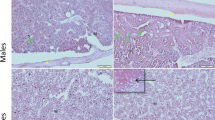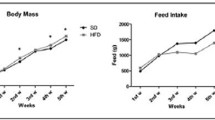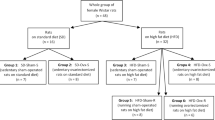Abstract
Purpose
Studies in humans suggest that consumption of low-carbohydrate, high-fat diets (LC–HF) could be detrimental for growth and bone health. In young male rats, LC–HF diets negatively affect bone health by impairing the growth hormone/insulin-like growth factor axis (GH/IGF axis), while the effects in female rats remain unknown. Therefore, we investigated whether sex-specific effects of LC–HF diets on bone health exist.
Methods
Twelve-week-old male and female Wistar rats were isoenergetically pair-fed either a control diet (CD), “Atkins-style” protein-matched diet (LC–HF-1), or ketogenic low-protein diet (LC–HF-2) for 4 weeks. In females, microcomputed tomography and histomorphometry analyses were performed on the distal femur. Sex hormones were analysed with liquid chromatography–tandem mass spectrometry, and endocrine parameters including GH and IGF-I were measured by immunoassay.
Results
Trabecular bone volume, serum IGF-I and the bone formation marker P1NP were lower in male rats fed both LC–HF diets versus CD. LC–HF diets did not impair bone health in female rats, with no change in trabecular or cortical bone volume nor in serum markers of bone turnover between CD versus both LC–HF diet groups. Pituitary GH secretion was lower in female rats fed LC–HF diet, with no difference in circulating IGF-I. Circulating sex hormone concentrations remained unchanged in male and female rats fed LC–HF diets.
Conclusion
A 4-week consumption of LC–HF diets has sex-specific effects on bone health—with no effects in adult female rats yet negative effects in adult male rats. This response seems to be driven by a sex-specific effect of LC–HF diets on the GH/IGF system.





Similar content being viewed by others
References
Sharma S, Jain P (2014) The modified Atkins diet in refractory epilepsy. Epilepsy Res Treat 2014:404202. doi:10.1155/2014/404202
Mackay MT, Bicknell-Royle J, Nation J, Humphrey M, Harvey AS (2005) The ketogenic diet in refractory childhood epilepsy. J Paediatr Child Health 41(7):353–357. doi:10.1111/j.1440-1754.2005.00630.x
Atallah R, Filion KB, Wakil SM, Genest J, Joseph L, Poirier P, Rinfret S, Schiffrin EL, Eisenberg MJ (2014) Long-term effects of 4 popular diets on weight loss and cardiovascular risk factors: a systematic review of randomized controlled trials. Circ Cardiovasc Qual Outcomes 7(6):815–827. doi:10.1161/CIRCOUTCOMES.113.000723
Bielohuby M, Sisley S, Sandoval D, Herbach N, Zengin A, Fischereder M, Menhofer D, Stoehr BJ, Stemmer K, Wanke R, Tschop MH, Seeley RJ, Bidlingmaier M (2013) Impaired glucose tolerance in rats fed low-carbohydrate, high-fat diets. Am J Physiol Endocrinol Metab 305(9):E1059–E1070. doi:10.1152/ajpendo.00208.2013
Pissios P, Hong S, Kennedy AR, Prasad D, Liu FF, Maratos-Flier E (2013) Methionine and choline regulate the metabolic phenotype of a ketogenic diet. Mol Metab 2(3):306–313. doi:10.1016/j.molmet.2013.07.003
Bielohuby M, Menhofer D, Kirchner H, Stoehr BJ, Muller TD, Stock P, Hempel M, Stemmer K, Pfluger PT, Kienzle E, Christ B, Tschop MH, Bidlingmaier M (2011) Induction of ketosis in rats fed low-carbohydrate, high-fat diets depends on the relative abundance of dietary fat and protein. Am J Physiol Endocrinol Metab 300(1):E65–E76. doi:10.1152/ajpendo.00478.2010
Ellenbroek JH, van Dijck L, Tons HA, Rabelink TJ, Carlotti F, Ballieux BE, de Koning EJ (2014) Long-term ketogenic diet causes glucose intolerance and reduced beta- and alpha-cell mass but no weight loss in mice. Am J Physiol Endocrinol Metab 306(5):E552–E558. doi:10.1152/ajpendo.00453.2013
Jornayvaz FR, Jurczak MJ, Lee H-Y, Birkenfeld AL, Frederick DW, Zhang D, Zhang X-M, Samuel VT, Shulman GI (2010) A high-fat, ketogenic diet causes hepatic insulin resistance in mice, despite increasing energy expenditure and preventing weight gain. Am J Physiol Endocrinol Metab 299(5):E808–E815. doi:10.1152/ajpendo.00361.2010
Bielohuby M, Sawitzky M, Stoehr BJ, Stock P, Menhofer D, Ebensing S, Bjerre M, Frystyk J, Binder G, Strasburger C, Wu Z, Christ B, Hoeflich A, Bidlingmaier M (2011) Lack of dietary carbohydrates induces hepatic growth hormone (GH) resistance in rats. Endocrinology 152(5):1948–1960. doi:10.1210/en.2010-1423
Caton SJ, Bielohuby M, Bai Y, Spangler LJ, Burget L, Pfluger P, Reinel C, Czisch M, Reincke M, Obici S, Kienzle E, Tschop MH, Bidlingmaier M (2012) Low-carbohydrate high-fat diets in combination with daily exercise in rats: effects on body weight regulation, body composition and exercise capacity. Physiol Behav 106(2):185–192. doi:10.1016/j.physbeh.2012.02.003
Aaseth J, Boivin G, Andersen O (2012) Osteoporosis and trace elements—an overview. J Trace Elem Med Biol 26(2–3):149–152. doi:10.1016/j.jtemb.2012.03.017
Peterson SJ, Tangney CC, Pimentel-Zablah EM, Hjelmgren B, Booth G, Berry-Kravis E (2005) Changes in growth and seizure reduction in children on the ketogenic diet as a treatment for intractable epilepsy. J Am Diet Assoc 105(5):718–725. doi:10.1016/j.jada.2005.02.009
Williams S, Basualdo-Hammond C, Curtis R, Schuller R (2002) Growth retardation in children with epilepsy on the ketogenic diet: a retrospective chart review. J Am Diet Assoc 102(3):405–407
Blouin K, Despres JP, Couillard C, Tremblay A, Prud’homme D, Bouchard C, Tchernof A (2005) Contribution of age and declining androgen levels to features of the metabolic syndrome in men. Metab Clin Exp 54(8):1034–1040. doi:10.1016/j.metabol.2005.03.006
Nguyen TV, Sambrook PN, Eisman JA (1998) Bone loss, physical activity, and weight change in elderly women: the Dubbo Osteoporosis Epidemiology Study. J Bone Miner Res 13(9):1458–1467. doi:10.1359/jbmr.1998.13.9.1458
Giustina A, Mazziotti G, Canalis E (2008) Growth hormone, insulin-like growth factors, and the skeleton. Endocr Rev 29(5):535–559. doi:10.1210/er.2007-0036
Bielohuby M, Matsuura M, Herbach N, Kienzle E, Slawik M, Hoeflich A, Bidlingmaier M (2010) Short-term exposure to low-carbohydrate, high-fat diets induces low bone mineral density and reduces bone formation in rats. J Bone Miner Res 25(2):275–284. doi:10.1359/jbmr.090813
Frommelt L, Bielohuby M, Stoehr BJ, Menhofer D, Bidlingmaier M, Kienzle E (2014) Effects of low-carbohydrate, high-fat diets on apparent digestibility of minerals and trace elements in rats. Nutrition 30(7–8):869–875. doi:10.1016/j.nut.2013.11.017
Suzuki HK, Mathews A (1966) Two-color fluorescent labeling of mineralizing tissues with tetracycline and 2,4-bis[N,N′-di-(carbomethyl)aminomethyl] fluorescein. Stain Technol 41(1):57–60
Abramoff M, Magalhaes P, Ram S (2004) Image processing with ImageJ. Biophotonics Int 11:36–42
Doube M, Klosowski MM, Arganda-Carreras I, Cordelieres FP, Dougherty RP, Jackson JS, Schmid B, Hutchinson JR, Shefelbine SJ (2010) BoneJ: free and extensible bone image analysis in ImageJ. Bone 47(6):1076–1079. doi:10.1016/j.bone.2010.08.023
Baldock PA, Sainsbury A, Couzens M, Enriquez RF, Thomas GP, Gardiner EM, Herzog H (2002) Hypothalamic Y2 receptors regulate bone formation. J Clin Investig 109(7):915–921. doi:10.1172/JCI14588
Bielohuby M, Popp S, Bidlingmaier M (2012) A guide for measurement of circulating metabolic hormones in rodents: pitfalls during the pre-analytical phase. Mol Metab 1(1–2):47–60. doi:10.1016/j.molmet.2012.07.004
Fanelli F, Belluomo I, Di Lallo VD, Cuomo G, De Iasio R, Baccini M, Casadio E, Casetta B, Vicennati V, Gambineri A, Grossi G, Pasquali R, Pagotto U (2011) Serum steroid profiling by isotopic dilution-liquid chromatography-mass spectrometry: comparison with current immunoassays and reference intervals in healthy adults. Steroids 76(3):244–253. doi:10.1016/j.steroids.2010.11.005
Xu J, Bekaert AJ, Dupont J, Rouve S, Annesi-Maesano I, De Magalhaes Filho CD, Kappeler L, Holzenberger M (2011) Exploring endocrine GH pattern in mice using rank plot analysis and random blood samples. J Endocrinol 208(2):119–129. doi:10.1677/JOE-10-0317
Arnetz L, Ekberg NR, Alvarsson M (2014) Sex differences in type 2 diabetes: focus on disease course and outcomes. Diabetes Metab Syndr Obes 7:409–420. doi:10.2147/DMSO.S51301
Kautzky-Willer A, Handisurya A (2009) Metabolic diseases and associated complications: sex and gender matter! Eur J Clin Investig 39(8):631–648. doi:10.1111/j.1365-2362.2009.02161.x
Leitner MK, Kautzky-Willer A (2013) Gender-specific differences in age-associated endocrinology. Z Gerontol Geriatr 46(6):505–510. doi:10.1007/s00391-013-0512-x
Rasul S, Ilhan A, Wagner L, Luger A, Kautzky-Willer A (2012) Diabetic polyneuropathy relates to bone metabolism and markers of bone turnover in elderly patients with type 2 diabetes: greater effects in male patients. Gend Med 9(3):187–196. doi:10.1016/j.genm.2012.03.004
Morselli E, Fuente-Martin E, Finan B, Kim M, Frank A, Garcia-Caceres C, Navas CR, Gordillo R, Neinast M, Kalainayakan SP, Li DL, Gao Y, Yi CX, Hahner L, Palmer BF, Tschop MH, Clegg DJ (2014) Hypothalamic PGC-1alpha protects against high-fat diet exposure by regulating ERalpha. Cell Rep 9(2):633–645. doi:10.1016/j.celrep.2014.09.025
Kim AM, Tingen CM, Woodruff TK (2010) Sex bias in trials and treatment must end. Nature 465(7299):688–689. doi:10.1038/465688a
Zucker I, Beery AK (2010) Males still dominate animal studies. Nature 465(7299):690. doi:10.1038/465690a
Bergqvist AG, Schall JI, Stallings VA, Zemel BS (2008) Progressive bone mineral content loss in children with intractable epilepsy treated with the ketogenic diet. Am J Clin Nutr 88(6):1678–1684. doi:10.3945/ajcn.2008.26099
Hahn TJ, Halstead LR, DeVivo DC (1979) Disordered mineral metabolism produced by ketogenic diet therapy. Calcif Tissue Int 28(1):17–22
Kim JT, Kang HC, Song JE, Lee MJ, Lee YJ, Lee EJ, Lee JS, Kim HD (2013) Catch-up growth after long-term implementation and weaning from ketogenic diet in pediatric epileptic patients. Clin Nutr 32(1):98–103. doi:10.1016/j.clnu.2012.05.019
Gras D, Roze E, Caillet S, Meneret A, Doummar D, Billette de Villemeur T, Vidailhet M, Mochel F (2014) GLUT1 deficiency syndrome: an update. Rev Neurol 170(2):91–99. doi:10.1016/j.neurol.2013.09.005
Bertoli S, Trentani C, Ferraris C, De Giorgis V, Veggiotti P, Tagliabue A (2014) Long-term effects of a ketogenic diet on body composition and bone mineralization in GLUT-1 deficiency syndrome: a case series. Nutrition 30(6):726–728. doi:10.1016/j.nut.2014.01.005
Ho KY, Leong DA, Sinha YN, Johnson ML, Evans WS, Thorner MO (1986) Sex-related differences in GH secretion in rat using reverse hemolytic plaque assay. Am J Physiol 250(6 Pt 1):E650–E654
Jansson JO, Eden S, Isaksson O (1985) Sexual dimorphism in the control of growth hormone secretion. Endocr Rev 6(2):128–150. doi:10.1210/edrv-6-2-128
Tabb MM, Sun A, Zhou C, Grun F, Errandi J, Romero K, Pham H, Inoue S, Mallick S, Lin M, Forman BM, Blumberg B (2003) Vitamin K2 regulation of bone homeostasis is mediated by the steroid and xenobiotic receptor SXR. J Biol Chem 278(45):43919–43927. doi:10.1074/jbc.M303136200
Ichikawa T, Horie-Inoue K, Ikeda K, Blumberg B, Inoue S (2007) Vitamin K2 induces phosphorylation of protein kinase A and expression of novel target genes in osteoblastic cells. J Mol Endocrinol 39(4):239–247. doi:10.1677/JME-07-0048
Hughes JM, Petit MA (2010) Biological underpinnings of Frost’s mechanostat thresholds: the important role of osteocytes. J Musculoskelet Neuronal Interact 10(2):128–135
Acknowledgments
We thank Sarina Benedix and Amon Horngacher (Medizinische Klinik und Poliklinik IV, Munich, Germany) for excellent technical assistance. A. Z was partly funded by a grant from the DAAD (Deutscher Akademischer Austauschdienst). This study was partly supported by a grant from the Else Kröner-Fresenius-Stiftung (Grant to MaBid, No. 2014_A108). A. Z., M. B. and M. B. designed research; A. Z., B. K., Y. C., M. B., R. S., E. S., N. H., F. F., M. M. and S. M. conducted research; A. Z. and M. B. analysed data; A. Z., M. B. and M. B. wrote the paper; M. B. had primary responsibility for final content. All authors read and approved the final manuscript.
Author information
Authors and Affiliations
Corresponding author
Additional information
Ayse Zengin and Benedikt Kropp have contributed equally to this work.
Rights and permissions
About this article
Cite this article
Zengin, A., Kropp, B., Chevalier, Y. et al. Low-carbohydrate, high-fat diets have sex-specific effects on bone health in rats. Eur J Nutr 55, 2307–2320 (2016). https://doi.org/10.1007/s00394-015-1040-9
Received:
Accepted:
Published:
Issue Date:
DOI: https://doi.org/10.1007/s00394-015-1040-9




